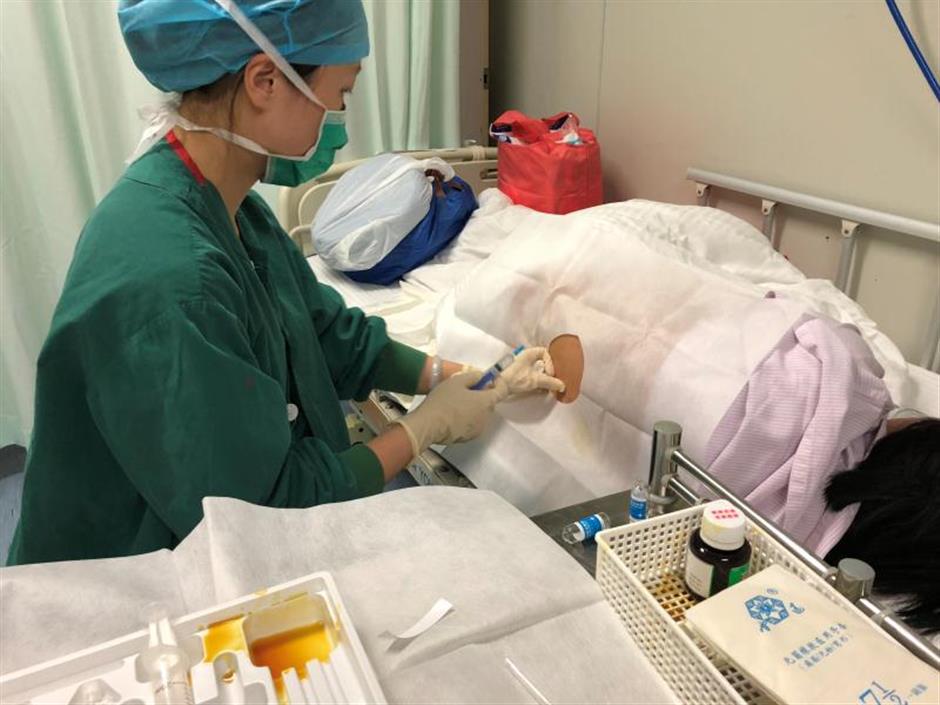Labor pain relief to benefit more women in Shanghai
Relief from labor pains through epidural anesthesia is common in developed countries, but only one in 10 new mothers in China has access to it.
The percentage is much higher in some maternity hospitals and in most major cities, but the nation still lags behind Western nations in taking unbearable pain out of childbirth.
One major reason is a shortage of anesthesiologists.
To address the increasing need, China’s National Health Commission unveiled a three-year-plan last November to introduce childbirth pain relief to more hospitals. In Shanghai, some hospitals are ahead of the national initiative.
At Shanghai No. 6 People’s Hospital in Xuhui District, some 140 women have received epidural anesthesia during childbirth since October last year, the hospital told Shanghai Daily. One of them is a 26-year-old woman surnamed Yang, who gave birth to her first child on January 22.
“My mother told me that labor pain is endurable, but when it started, I found it simply too overwhelming,” she said.
Yang said her water broke at 3am at home and she went to the hospital immediately. By 8am, the pain started to get the better of her.
“Every three minutes, I felt as if numerous needles were pricking my belly,” she said. “The pain made it impossible for me to communicate on my phone with my husband, who wasn’t allowed in the maternity area.”
Yang asked for relief, and the epidural anesthesia significantly reduced the pain. She gave birth to a boy that afternoon. Mother and son are doing well.

Yang and her husband and new-born baby in a ward of Shanghai No. 6 People’s Hospital
Under epidural anesthesia, a local anesthetic is injected into a small area of the back and a small tube is left in the epidural space to sustain medication.
Zhang Xiaoli, director of the anesthesiology department at the hospital, said Chinese hospitals started to significantly promote childbirth pain relief in 1990s, but a persistent lack of anesthesiologists has restricted its use.
By the end of 2016, the average number of anesthesiologists per 10,000 Chinese people was 0.5, while the number in some developed countries in Europe is 2.5 to 3.
“Over the years, anesthesiologists in China have been taking up more and more duties outside traditional surgery rooms,” Zhang said. “For example, we now provide painless gastrointestinal endoscopy, brain stent placement and assisted reproduction.”
Further complicating the situation is the fact that an anesthesiologist has to stand by in delivery rooms even when not busy all the time.
“Childbirth is not like a surgery or a check-up that is scheduled ahead of time,” Zhang said. “Obviously, it can’t be planned. On the other hand, it’s also impossible for an anesthesiologist in a surgery room to leave for urgent needs in a maternity ward.”
Beginning last October, the hospital assigned one anesthesiologist to work in the obstetrics and gynecology department.
Zhang said currently 40 percent of all women undergoing natural childbirth have access to pain relief, and the percentage is expected to rise as the service is better staffed in the future.
“Young women today are much more spoiled and also exercise less than the older generation, and the fear of pain drives many to choose Caesarean birth, which is less desirable than natural birth,” said Huang Yajuan, director of the obstetrics and gynecology department. “They actively look for hospitals that offer childbirth pain relief as an alternative.”
Huang said more readily available pain relief might encourage more women to have a second child.
“Women who have had a Caesarean birth are more prone to hemorrhaging of the uterus during a second pregnancy and labor,” she said.
At Shanghai First Maternity and Infant Hospital, one of the first hospitals in Shanghai to provide epidural anesthesia, 78 percent of women undergoing natural labor last year received pain relief, up from 40 to 50 percent in 2013.
The hospital provides 24/7 anesthesiology services to women in labor. In the past year, an average 30 epidural anesthesia procedures were performed every day.

A nurse anesthetist provides epidural anesthesia for a woman in labor at Shanghai First Maternity and Infant Hospital.
“We should help women when they need help the most,” said Liu Zhiqiang, director of the anesthesiology department at the hospital.
As epidural anesthesia becomes more common, misconceptions about its use are being dispelled. For example, many people believed that the procedure would be detrimental to mother and baby, Liu said.
“To those who still harbor doubts, the anesthesiologists tell them that even women doctors use it when giving birth,” he said.
By October last year, 44 of 58 hospitals in Shanghai that account for nine in 10 births were providing epidural anesthesia, and 37 percent of women undergoing natural birth used it, according to the results of a survey by anesthesiologists in the city.
In East China, the average rate of new mothers benefiting from epidural anesthesia is 30 percent, leading the whole country. In China’s northwest, by contrast, the rate is only 1.02 percent, the same survey shows.















